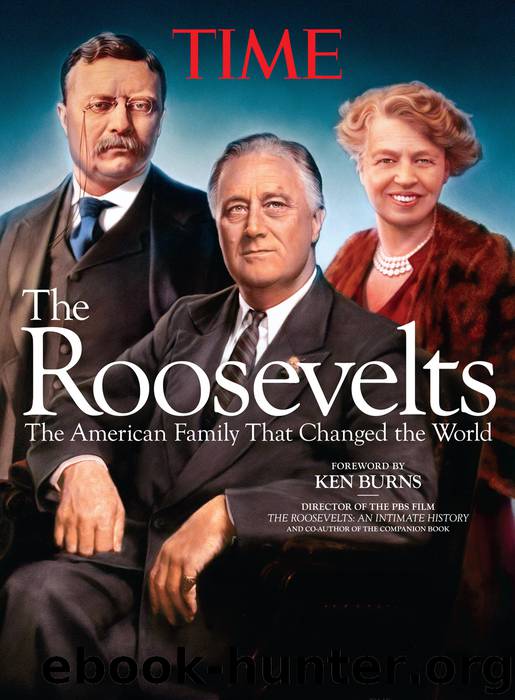TIME the Roosevelts by The Editors of TIME

Author:The Editors of TIME
Language: eng
Format: epub
Tags: BIO011000;HIS036060;
Publisher: Liberty Street
Published: 2016-03-01T20:30:00+00:00
THE ACTIVE LIFE With Eleanor on Campobello Island, Canada, in 1920. Polio would strike the next year.
After his first address on the banking crisis, in which he explained to families why it was safer to return their money to the banks than keep it hidden at home, large deposits began flowing back into the banking system. When he asked people to spread a map before them in preparation for a fireside chat on the war in the Pacific, map stores sold more maps in a span of days than they had in an entire year. When he announced a rubber shortage that Americans could help fill, millions of householders, delighted at the call for service, reached into their homes and yards to recover old rubber tires still hanging from trees as swings for their kids, as well as old garden hoses, rubber shoes and even rubber girdles.
Roosevelt purposely limited his fireside talks to an average of two or three a year, in contrast to the modern presidential practice of weekly radio addresses. Timed at dramatic moments, they commanded gigantic audiences, larger than any other program on the radio, including the biggest prizefights and the most popular comedy shows. The novelist Saul Bellow recalled walking down the street on a hot summer night in Chicago while Roosevelt was speaking. Through lit windows, families could be seen sitting at their kitchen table or gathered in the parlor listening to the radio. Under the elm trees, “drivers had pulled over, parking bumper to bumper, and turned on their radios to hear Roosevelt. They had rolled down the windows and opened the car doors. Everywhere the same voice. You could follow without missing a single word as you strolled by.”
The press conference became another critical tool in reaching the hearts and minds of the American people. At his very first conference, Roosevelt announced he was suspending the wooden practice of requiring written questions submitted in advance. He promised to meet reporters twice a week and by and large kept his promise, holding nearly 1,000 press conferences in the course of his presidency. Talking in a relaxed style with reporters, he explained legislation, announced appointments and established friendly contact, calling them by their first name, teasing them about their hangovers, exuding warmth. Roosevelt’s accessibility to the working reporters helped explain the paradox that although 80% to 85% of the newspaper publishers regularly opposed his policies, his coverage was generally full and fair.
Though the national economy remained in a depressed state until the war broke out, the massive programs of the New Deal had stopped the precipitous slide and provided an economic floor for tens of millions of Americans. “We aren’t on relief anymore,” one woman noted with pride. “My husband is working for the government.” The despair that had hung over the land was lifted, replaced by a bustling sense of movement and activity, a renewed confidence in the future, a revived faith in democracy. “There is a mysterious cycle in human events,” FDR said when he accepted his party’s nomination for a second term.
Download
This site does not store any files on its server. We only index and link to content provided by other sites. Please contact the content providers to delete copyright contents if any and email us, we'll remove relevant links or contents immediately.
Among the Betrayed by Margaret Peterson Haddix(11410)
05 Trials of Death by Darren Shan(6238)
Ranger's Apprentice 1 - The Ruins of Gorlan by John Flanagan(5714)
The Power of Now: A Guide to Spiritual Enlightenment by Eckhart Tolle(5336)
Percy Jackson 1 - The Lightning Thief by Riordan Rick(4716)
Suicide Notes by Michael Thomas Ford(4653)
I'm Still Scared by Tomie dePaola(4216)
Pocahontas by Joseph Bruchac(4030)
The miraculous journey of Edward Tulane by Kate DiCamillo(3962)
The Book Thief by Markus Zusak(3884)
07 Hunters of the Dusk by Darren Shan(3558)
The 101 Dalmatians by Dodie Smith(3303)
The Science Book (Big Ideas Simply Explained) by DK(3136)
Winnie_The_Pooh by A. A. Milne(2829)
Harry Potter 4 - Harry Potter and The Goblet of Fire by J.K.Rowling(2805)
The Ring of Sky by Chris Bradford(2749)
The Little Prince by Antoine de Saint-Exupéry(2732)
The Wrath and the Dawn by Ahdieh Renee(2634)
0041152001443424520 .pdf by Unknown(2599)
